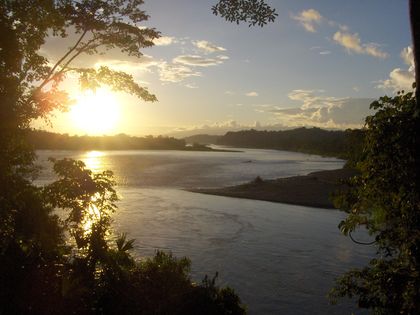Ecuador - Environment

As of 2000, Ecuador's major environmental problems were erosion in the highland areas; deforestation, especially in the Oriente; and water pollution. The Ecuadoran Institute of Water Resources estimated that the amount of arid land increased by 31.5% between 1954 and 1979, when 7.5% of the coastal lowland and Sierra were classified as arid. Between 1981 and 1985, 340,000 hectares (840,000 acres) of land were deforested annually. By the 1990s, Ecuador had lost over 30% of the original mangrove area, which covered over 117,000 hectares.
As of 1994, it was estimated that, at current deforestation rates, coastal forests will be completely eliminated within 15 years and the Amazon forests will be gone within 40 years. Traditional farming practices have been blamed for most of these problems, but oil development has also played a role in the clearing of forests. A program for reforestation and maintenance of existing forests was initiated in 1979, but only 4,000 hectares (10,000 acres) were reforested annually during the early 1980s. Ecuador's principal environmental agency is the Ministry of Natural Resources and Energy. Land erosion is accelerated by deforestation.
Flooding and desertification are related problems which have damaged or eliminated valuable soil, particularly in the western coastal region. Water pollution is a problem due to the influx of domestic, industrial, and agricultural contaminants.
Ecuador's cities produce about 1.2 million tons of solid waste per year. The nation has 442 cu km of renewable water resources with 82% used for agricultural purposes. Some 90% of all urban dwellers and 75% of the rural population have access to pure drinking water.
The expansion of Ecuador's population centers threatens its wildlife. As of 2001, 28 species of mammals in a total of 302 are currently endangered. Fifty-three of 1,388 breeding bird species and 12 of 380 reptile species are also endangered. Of the 19,000–plus plant species in Ecuador, 642 are threatened with extinction. An extensive wildlife protection system was established in 1970. As of 2001, 42.6% of Ecuador's total land area was protected. Endangered species on the Ecuadoran mainland include the tundra peregrine falcon, yellow-tailed woolly monkey, five species of turtle (green sea, hawksbill, olive ridley, leatherback, and South American river), and three species of crocodile (spectacled caiman, black caiman, and American).
Endangered species in the Galápagos Islands include the dark-rumped petrel, Galápagos dark-rumped petrel (a subspecies), black petrel, African ass, two species of turtle (green sea and hawksbill), and the Galápagos giant tortoise and 11 of its subspecies. A subspecies of Galápagos giant tortoise is extinct, and another may be. Darwin's Galapagos mouse, the Fernandina Galapagos mouse, Charles Island tortoise, and the Duncan Island tortoise have become extinct.
Ecuador's natural attractions could lead to increased tourism, benefiting the economy. However, environmental problems, including further endangerment of native plants and animals, could be exacerbated without careful management of the areas attractive to tourists.
Does anyone have a reference to where this report came from? Or contact information to the Ecuadoran Institute of Water Resources?